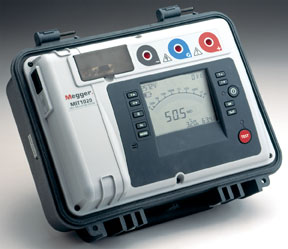Diagnostic Insulation Testing Digest
Insulation defects are the most common cause of electrical failure or damage. Regular testing of the quality of the insulation is a decisive part of every maintenance program.
Only by regular testing can you get the information required to minimize Equipment failure and to plan investments and maintenance programs. Comparing the results of a simple test of the insulation resistance against the limits established for the equipment gives a pass/fail decision. But is a “pass” really a good result? What does fail mean? Where is the problem?
Induced Currents
When we subject a test object to a test voltage, we can measure the induced current and calculate the insulation resistance using Ohm’s law. Unfortunately, the picture is complicated by the fact that the instrument will display a result which is the sum of the following components;
- Capacitive charging current
- Absorption- or polarizing current
- Surface leakage current
- Leakage current
The capacitive charging current quickly falls to zero, whereas the absorption current falls more slowly as the molecules in the insulation become polarized. After this charging period, just the leakage current and the surface leakage current remain. Understanding these currents and applying some of the following diagnostic techniques which are built into some of Megger’s latest insulation testers allows the operator to better understand the quality of the insulation and identify problems. Each test is designed to offer a different insight into the condition of the insulation. Test voltages no more than 10kV ensure these tests are totally none destructive to insulation, the aim after all is to analyze and diagnose the condition of insulation not over stress it.

Insulation and Continuity Tester – The new Megger MIT400 Series insulation and continuity testers has been designed for electrical testing by power utilities, industrial, telecommunication companies, commercial and domestic electricians.
Guard Terminal
Surface leakage current can be diverted round the test instrument measurement circuit using the guard terminal Surface leakage current between the test leads will be present if the insulation is contaminated by dampness, grease or salts. However always check the performance of the Guard terminal when selecting an instrument. Megger provides this important information.
Dielectric Absorption Ratio (DAR)
Good insulation will show increasing resistance during the test as the charging currents disappear. In poor insulation the high leakage currents will hide the charging currents, and a graph of the insulation resistance over time will show a much flatter curve. With certain insulating materials it can take hours for the insulation to become polarized and for the absorption current to fall to zero. How can you make a quick evaluation of the insulation in such situations? Based upon the principle of good insulation showing an increasing insulation resistance test result with time, the DAR is a ratio derived from two results at particular points in time during a test. It has the advantage of being quick, sometimes no more than 60 seconds, and can be seen as independent of temperature. The two time points selected for the DAR test can be defined by the user, and 60seconds/30 seconds is typical. The test is useful in showing up damp or contaminated insulation Because the concept relies on relatively rigid insulating structures, it is however not suitable for use on insulating oils.
Polarization-Index Test (PI)
A popular DAR test is the Polarization-Index Test. Two measurements are taken, at 1 minute and at 10 minutes, and these results are used to calculate a PI ratio.
Step Voltage Test (SV)
Because good insulation is resistive, an increase in test voltage will lead to an increase in current, with the result that the resistance remains constant. A deviation in resistance as voltage increases indicates a problem with the insulation. This test procedure is a good way to locate pinholes and cracks in the insulating material, where ionization occurs and reduces the insulation resistance.
Dielectric Discharge Test (DD)
Bad layers within an insulation are characterized by high absorption currents. If you fully charge the insulation, and then continue to measure in the discharge phase, then within the first few seconds the leakage currents disappear and the capacitance is discharged, leaving just the absorption current for the test instrument to measure. If a layer of insulation is defect, it would be expected to show reduced leakage resistance, but the same capacitance. The DD is a value calculated from the current, capacitance and test voltage, and can indicate problems in individual layers of the insulation.
Burn Mode
To locate a fault it can sometimes be beneficial to create and maintain an arc at the fault so that the ionization can be detected.
Temperature and Humidity
Temperature changes can have a significant effect on the insulation resistance measurement. A 10-degree rise in temperature halves the resistance. This effect can be quantified, and temperature correction tables can be used to help evaluate test results. Humidity effects are unfortunately not so easy to quantify, as different insulating materials absorb moisture to different extents, which can also be dependent upon the age and condition of the equipment. An attempt should however be made to account for the effect of humidity on the test result.
Measure Current or Resistance?
Insulation testers measure current and calculate the resistance. One of the reasons for this is probably just that it is traditional. Good insulation gives a high resistance value, poor insulation gives low results. Furthermore, good insulation is resistive; increasing the test voltage increases the current, but the resistance should stay the same. Some faults are however easier to identify by observing the change in current. Many insulation testers give you the choice of seeing the result in either resistance or current.
Latest posts by Mike Novello (see all)
- Used Bio-Rad Gel Doc XR For Sale - March 9, 2022
- CONSULTIX WTX-35-A4 CW Test Kit For Sale - November 9, 2021
- Biologic SP-150 Single Channel Potentiostat and VMP3B-80 Booster For Sale - September 7, 2021










